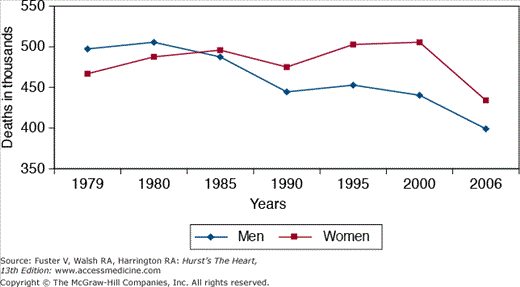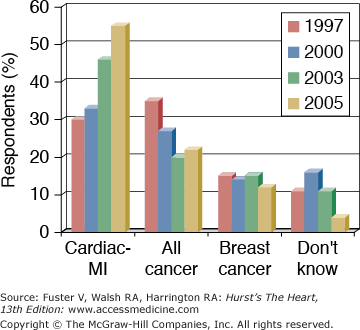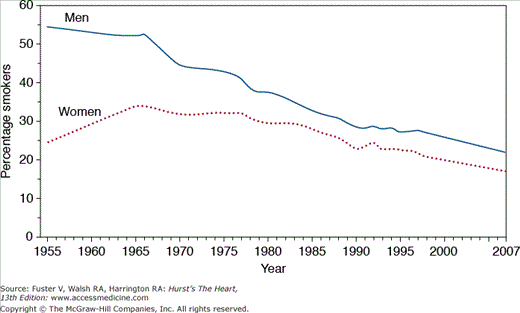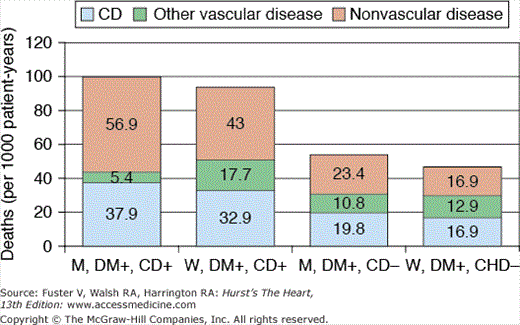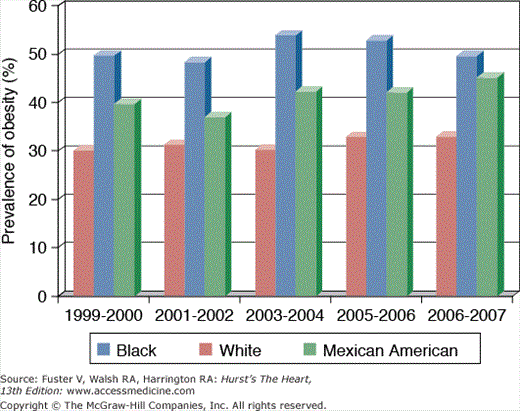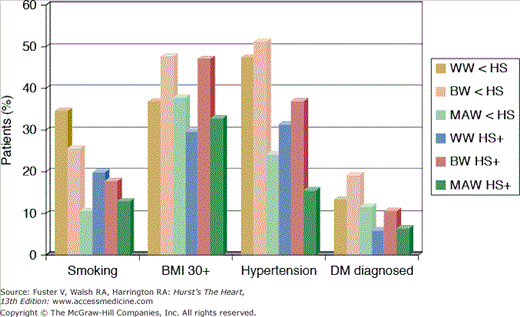Women and Coronary Artery Disease: Introduction
Cardiovascular (CV) mortality trends have finally begun to decrease among women in the United States similar to the pattern noted in men since the 1980s (Fig. 103–1). The importance of coronary artery disease (CAD) and its prevention in women is gradually receiving increased physician and public attention.1-4 Evidence-based guidelines have been updated after an expert panel review of the literature for the prevention of CAD in women.2 Exploration of sex differences has increased.3 Yet an online survey of primary care physicians, gynecologists, and cardiologists5 found that fewer than 20% of physicians were aware that more women than men die annually of CAD. Intermediate-risk women, defined by Framingham criteria, were more likely to be defined as low risk by the physicians surveyed. Similarly, among more than 1000 American women interviewed by telephone in 2005, only 55% identified heart attack and heart disease as the major cause of mortality for women; this was an improvement from 30% of women surveyed in 19974 (Fig. 103–2). In contrast, 61% of the women reported heart disease as the leading cause of mortality in men. There was substantial ethnic variation among the responses of the women surveyed in 2005 (white, 62%; black, 38%; and Hispanic women, 34%). Interestingly, the most frequent reason women had not discussed heart health with their physicians was that their providers did not bring up this issue (38%).
Figure 103–1.
Graph comparing rates of coronary artery disease and mortality for women and men, 1979 to 2006. From Lloyd-Jones D, Adams RJ, Brown TM, et al. American Heart Association Statistics Committee and Stroke Statistics Subcommittee. Heart disease and stroke statistics–2010 update: A report from the American Heart Association. Circulation. 2010 Feb 23;121(7):e46–e215..
Figure 103–2.
Trends in American women’s perception of the leading cause of death in women. MI, myocardial infarction. Reproduced with permission from Mosca et al.5
Prevention: Sex-Specific Issues
Tobacco exposure is the single most important coronary artery risk factor for women and men.1,6,7 In epidemiologic studies, greater tobacco exposure in amount and duration is related to higher CAD events in a dose-related fashion.6-8 Median smoking prevalence in 2007 was 21.3% for men and 18.4% for women.9 Among women, more Native American women smoke (26.8%) than white (20%) or black women (17.3%), with lower rates among Hispanic (11.1%) and Asian women (6.1%).10 Cigarette smoking has been associated with an earlier age of first myocardial infarction (MI) (see also Chap. 51) and menopause.6 Because middle-aged women experience less symptomatic CAD than middle-aged men, the increased risk of MI and sudden death related to tobacco use is greater for women than men.
Over the past several decades, American women’s personal use of cigarettes has not decreased as dramatically as it has among men (Fig. 103–3). The prevalence of cigarette use among women reflects both higher initiation rates and lower initial and long-term cessation rates.6,7 However, successful tobacco cessation for women, as for men, dramatically decreases the risk of further coronary events.6-8 Black smokers also have low both short- and long-term cigarette cessation rates.6,11
Figure 103–3.
Prevalence of smoking among men and women age 18 years and younger in the United States. Before 1992, current smokers were defined as persons who reported having smoked more than 100 cigarettes and who currently smoked. Since 1992, current smokers are defined as persons who reported having smoked more than 100 cigarettes during their lifetime and who reported now smoking every day or some days. Reproduced with permission from Centers for Disease Control and Prevention.9
Women contemplating smoking cessation are often concerned about potential weight gain, a common consequence of efforts to stop smoking.6,12 Weight gain with tobacco cessation is on average 7 to 10 lb, with fewer than 10% gaining more than 20 lb. Weight gain tends to be higher among women, blacks, and smokers who inhale more than 25 cigarettes per day. Women smokers report that they are unwilling to experience any or minimal weight increase as a result of smoking cessation.6,10 Yet smokers trying to lose weight are still interested in discontinuing the use of tobacco.12 To avoid the weight gain common with tobacco cessation, several types of interventions have been recommended.6 Realistic expectations may be helpful as well as exercise, careful choice of snacks, and appropriate pharmacotherapy. Increasing physical activity contributes to success in smoking cessation even if it does not modify weight gain.13
Multiple pharmacologic therapies are available.6,7,11,14-16 Nicotine replacement products approximately double the rate of successful tobacco cessation.5,6,14 The patch has the highest compliance rate and provides smoother levels than the gum, spray, or lozenge. However, in a meta-analysis comparing the efficacy of nicotine products in women and men, efficacy was similar up to 6 months follow-up only.14 Bupropion has been found to be effective in improving tobacco cessation rates in both white and black smokers15 and is reported to minimize weight gain while it is used.6,15 Because bupropion increases the metabolic rate, when it is stopped, weight gain occurs. Although bupropion is an antidepressant, it has been effective in smokers who are not depressed. Bupropion is contraindicated in patients with a history of seizures, head trauma, or heavy alcohol consumption (because it lowers the seizure threshold). Bupropion can exacerbate symptoms related to anorexia and bulimia and should be avoided if there is a history of these disorders or recent use of a monoamine oxidase inhibitor. Varenicline has been found to be effective and safe in women and men with stable CAD.16 It has been observed that black smokers may have more trouble giving up tobacco than white smokers.15,17 Physiologic addiction in black smokers may previously have been underestimated, resulting in undertreatment of nicotine addiction. In a comparison of black and white smokers consuming similar amounts of tobacco, black smokers were found to have higher blood levels of cotinine than white smokers.16
Many surveys reveal that physicians can have a powerful effect on smoking cessation, even with minimal effort.6,7 Programs that promote activities to minimize weight gain and stress social support may be more effective for women. Substantial evidence suggests that avoiding tobacco exposure is important for women.1-3.6-9 Additional research about sex and racial differences is needed.
Diabetic individuals have higher mortality rates from CAD than nondiabetics18-23 (see also Chap. 91). In the past decade, coronary heart disease (CHD) mortality rates have increased by 23% in diabetic women, but they have decreased by 27% in nondiabetic women. This is in comparison with diabetic men, in whom mortality rates have declined by 13%, but they have decreased by 36% in nondiabetic men.16 A prospective 25-year follow-up from Scotland revealed the highest mortality rates among those with both diabetes and known CHD with the hazard ratios (HRs) especially high for women at 1.97 (95% confidence interval [CI], 1.27-3.08; P = .003) compared with women with neither risk factor17 (Fig. 103–4). The higher CAD risk for diabetic women has been noted in multiple population studies.18,19 It has been postulated that sex differences in endothelial function, especially endothelial-dependent vasodilation, may play a pathophysiologic role.19 Diabetic women have CAD rates similar to those of diabetic men, so the usual “female advantage” of later onset of CAD is lost.
Figure 103–4.
Mortality in diabetic patients followed prospectively for 25 years. Mortality (deaths per 1000 patient-years) from coronary heart disease (CD), other vascular disease, and nonvascular causes in men (M) and women (W) with and without diabetes (DM+ and DM–, respectively) and known coronary heart disease (CD+ and CD–, respectively). Data from Whiteley et al.19
The lifetime risk of developing CV disease (CVD) is related to the presence or absence of both diabetes and obesity.18 In the Framingham Heart Study, over 30 years, CVD occurred in 78% of women with diabetes compared with 38% women without diabetes. With more attention to weight, CVD over 30 years in nondiabetic women occurred in 46.7% of obese women without diabetes and 34.3% of normal weight women. Most importantly, given the expanding obesity epidemic, was that the risk of CVD over 30 years among obese women with diabetes was 78.8% but was only 54.8% in normal weight diabetic women.
Diabetic women also have higher in-hospital mortality after MI and an increased incidence of congestive heart failure (CHF) than do diabetic men.16 In a review of data from the National Registry of Myocardial Infarction (NRMI) II, women’s increased post-MI mortality was not associated with glycemic control but rather with hypertension and hyperlipidemia.20 Additional study may determine whether these observations reflect sex differences in risk factors, natural history, or how less aggressive CAD prevention in diabetic women plays a role. In telephone interviews of diabetic patients with CVD in 2001, aspirin use was reported by 54.7% of women and 82.7% of men (risk ratio [RR], 0.81; 95% CI, 0.70-0.90).21
For diabetic women, the dose–response hazards of tobacco use have been documented in the Nurses’ Health Study with 20 years of follow-up.7 The relative risk for a CAD event was 2.68 for current diabetic smokers of more than 15 cigarettes daily, 1.66 for current diabetic smokers of less than 15 cigarettes daily, and 1.21 for past diabetic smokers, all compared with women who had never smoked (P <.001 for trend). Diabetic women who had not smoked for 10 years had a risk similar to that of nonsmoking diabetic women.
Among participants in the Framingham Heart Study from 1997 to 2005, diabetics at age 50 years had greater increases in body mass index (BMI) and cholesterol compared with nondiabetics at age 60 years and similar decreases in systolic blood pressure and tobacco use. Blood pressure control in the 2000s was achieved only in about 15% of diabetics and 36% of nondiabetics despite the higher CV risk among diabetics. Clearly, increased control of other CV risk factors is essential to decrease the overall CV risk associated with diabetes.24
Women at risk for developing diabetes include obese women and those who have experienced gestational diabetes (compared with women who have had a pregnancy without glucose intolerance).18 Greater weight is associated with greater insulin resistance as well as a higher rate of glucose intolerance. Even a moderate increase in physical activity (eg, walking 3 h/wk) and avoiding weight gain decreases the risk of developing diabetes.18
Women with insulin resistance, characterized by elevated levels of circulating insulin, often have associated glucose intolerance, higher levels of free fatty acids, central obesity, and hypertension and are also at greater risk of developing diabetes.18 The metabolic syndrome, defined in the Third Report of the National Cholesterol Education Program Expert Panel on Detection, Evaluation, and Treatment of High Blood Cholesterol25 to include obesity, glucose intolerance, hypertension, and lipid abnormalities, occurs in women and men at greater rates with increasing age (see Chap. 92). The metabolic syndrome is increasingly diagnosed at an early age26,27; tobacco exposure from 12 to 19 years of age dramatically increases the risk of having the metabolic syndrome.26 Polycystic ovarian syndrome (PCOS), with increased androgens, lower high-density lipoprotein (HDL) levels, and higher triglyceride levels and higher rates of CAD, may affect as many as 10% to 20% of women of childbearing age.27,28 Women with PCOS, compared with age-, race-, and socioeconomic-matched control subjects in their late 40s, more often had diabetes, hypertension, and hyperlipidemia and had a higher prevalence of coronary artery calcification.29 Pharmacologic and lifestyle interventions may improve prognosis (see Chap. 70 and 102). Aggressive management of tobacco use,8 lipoprotein abnormalities,18,24 and hypertension18 is beneficial. Regular exercise can also improve glucose and blood pressure control18 as well as insulin resistance.16
The prevalence of hypertension increases with advancing age; because life expectancy is greater for women than men, there are more elderly women with hypertension.30 Although women are more likely to have hypertension than men, there are substantial racial and ethnic variations in hypertension prevalence rates reported in Americans older than age 19 years, with black, non-Hispanic women (43.4%) and men (40.4%) having higher rates than white, non-Hispanic women (28.4%) and men (27.5%) as well as Mexican American women (27.8%) and men (26.7%) in 1999 to 2002.31 Sex differences in autonomic nervous system function may explain difficulties in blood pressure modulation in some premenopausal women when they are exposed to stress or vasoactive drugs.32
Both systolic and diastolic blood pressures have been found in population, cohort, and treatment studies to predict coronary events. Framingham data revealed that with a systolic blood pressure above 180 mm Hg, the annual incidence of CHD (angina, coronary insufficiency, MI, or death from these diagnoses) in women older than 65 years of age was above 30%, but for men older than age 65 years, it was approximately 50%.33 In other epidemiologic studies, higher diastolic blood pressure also predicted greater rates of clinical CAD.34 Through Framingham data analysis, predictors of new-onset isolated systolic hypertension included female sex, increasing age, and increased BMI during follow-up but not initial BMI.35
Although treatment trials have also documented that lowering blood pressure decreases the incidence of a first MI and sudden death, this effect has been less dramatic than the decrease in stroke occurrence with blood pressure control.30,35,36 Especially when older subjects were included in clinical trials, the benefit of treating hypertension to prevent coronary events has finally received greater recognition.
Sex-specific information about pharmacologic therapy of hypertension with angiotensin-converting enzyme (ACE) inhibitors and thiazide diuretics continues to evolve. ACE inhibitors should be used cautiously in women of reproductive age because teratogenic effects have been documented in the first trimester of pregnancy.37 Potentially fertile women must understand the potential risk to fetuses before initiating therapy. Infants with only first trimester ACE inhibitor exposure had an increased risk of CV and central nervous system malformations (RR, 2.71; CI, 1.72-4.27) compared with infants not exposed to antihypertensive medications; other antihypertensive medications did not increase the risk of congenital abnormalities. Cough, a common side effect of first-generation ACE inhibitors but not the angiotensin receptor blockers (ARBs), occurred substantially more frequently in women than in men.38 Thiazide diuretics are a preferred first choice in the treatment of hypertension in women as well as men (see Chap. 70) and are also beneficial for bone health. Epidemiologic studies have documented a reduction of approximately one-third in hip fractures with the use of thiazide diuretics. In a randomized, double-blind, placebo-controlled trial, thiazides were associated with preservation of hip and spine bone mineral density.37
There are sex differences in lipoprotein profiles and the impact of lipids on CV risk.39,40 Many experts consider HDL more predictive for women than any other lipoprotein component, with the strongest correlation between low HDL levels and CAD events. Low-density lipoprotein (LDL) levels increase with increasing age for both women and men and are especially predictive of events in men. Triglyceride levels may be especially important in women. In fact, one group of researchers suggest that enlarged waist (>88 cm) combined with elevated triglycerides (≥1.45 mmol/L) best prospectively identified postmenopausal women at CV risk followed over 8 years.41
Although secondary prevention with pharmacologic treatment of hyperlipidemia decreases CAD events in women as well as men,39,41 these agents are underprescribed for women after MI, and target treatment levels are often not reached.42 Primary prevention trials for hyperlipidemia in women with HMG-CoA reductase inhibitors (which simultaneously decrease LDL and increase HDL) have not demonstrated a reduction in mortality, perhaps related to low event rates.39 With the latest cholesterol treatment guidelines, diabetic women are candidates for primary prevention with aggressive treatment of lipid abnormalities.25 There is still controversy about the cost-to-benefit ratio for aggressive treatment in women at low risk for vascular disease.39
The prevalence of obesity in the United States has increased over the past 40 years.43 Substantial ethnic and racial differences in obesity as measured by BMI exist (Fig. 103–5). Although BMI reflects both weight and height, there is increasing recognition that black more than white obese individuals have greater lean muscle mass that may decrease the associated health risks.43 Racial differences in BMI, as well as glycosylated hemoglobin, start in childhood, with black and Mexican American girls having less favorable profiles than white girls.10
Figure 103–5.
Prevalence of obesity (body mass index ≥30) in the National Health and Nutrition Examination Survey (NHANES) in women age 20 years and older by race and age. Data from Flegal et al.43
Obesity is linked to multiple cardiac risk factors (including insulin resistance, diabetes, hypertension, and hyperlipidemia) and is independently associated with coronary artery event rates.43 The pattern of weight distribution is also predictive of coronary events, with more events among women with the “apple” shape, who have a greater central or abdominal girth, than among those with the “pear” shape, who have more weight on the hips and buttocks.43,44, A greater waist circumference increases health risk regardless of BMI.43,44
Increased physical activity or limited weight loss is associated with a decreased risk of CAD events.43,44 Behavioral interventions to decrease weight have been most successful when there is a physical activity component. A study of obese twins revealed that lack of physical activity correlated with the more obese twin.44 In the Nurses’ Health Study, both BMI above 25 and physical activity were important predictors of CHD in 20-year follow-up (Fig. 103–6).45 Although new pharmacologic treatments for obesity have been developed, many have been documented to be hazardous.46
Figure 103–6.
Selected cardiovascular risk factors for women by self-reported race and high school completion (fewer years of formal schooling or at least high school graduation). Smoking and told diabetes data from the Behavioral Risk Factor Surveillance System and Obesity (body mass index [BMI] ≥30) or hypertension defined by blood pressure above 140/90 mm Hg, self-reported current use of antihypertensive medication, or having been given a hypertension diagnosis by a health professional at least twice from the National Health and Nutrition Survey, 1999 to 2002. BW, black women; DM, diabetes mellitus; HS, high school; MAW, Mexican-American women; WW, white women. Data from Mensah et al.57
Women’s physiologic response to exercise includes a lower work capacity and oxygen uptake than men.1 This occurs because women’s cardiac output is predominantly increased by increasing heart rate. Men, in comparison, accomplish an increase in cardiac output predominantly by increasing stroke volume. In observing women health professionals over an average of 5 years, women who walked at least 1 hour each week had half the CHD rate as women who did not walk regularly.47 Both women and men benefit from referral to cardiac rehabilitation programs after MI; however, fewer women than men are referred and participate in cardiac rehabilitation.48
The importance of the menstrual cycle and menopause as risk factors for CAD in women is still being defined.49,50 Women with early menopause after gynecologic surgery have been considered at higher risk for CAD and osteoporosis on the basis of less hormonal exposure.51 However, a 1999 analysis from the Nurses’ Health Study found only women smokers with a younger age of menopause have a greater risk of CAD.50
Although population surveys suggested hormonal therapy after menopause may decrease the risk of CAD, women using hormones reported less tobacco exposure, greater levels of exercise, and readier access to medical care; they also tended to be healthier and wealthier.52,53 The Women’s Health Initiative (WHI), a prospective randomized clinical trial of women 50 to 79 years of age, revealed that the combination of estrogen and progestin after menopause increases CAD risk,52 and estrogen alone in women without a uterus does not decrease CAD risk.53 Estrogen alone is contraindicated in women with a uterus because of the associated increased risk of endometrial cancer. In the WHI subgroup analysis of women ages 50 to 59 years with 7-year follow-up, conjugated equine estrogen also was not protective.53 In contrast, the observational Nurses’ Health Study noted that women beginning hormonal therapy soon after menopause had lower CHD risk (RR, 0.72; 95% CI, 0.56-0.92 for estrogen and progesterone and RR, 0.6; 95% CI, 0.54-0.80 for estrogen alone) than women beginning treatment 10 years after menopause.54
National guidelines have reflected these results and emphasize modalities for the prevention of heart disease in women that do not include hormonal therapy.4 In counseling menopausal women, CV prevention should be included as a specific focus on common CV risk factors. Hormonal therapy use is currently limited to control severe vasomotor symptoms.
Both socioeconomic and psychological factors affect the prevalence and outcome of CAD55,56,58 (see Chap. 96). Coronary disease morbidity and mortality are greater among those of lower socioeconomic status (SES).55,56 Markers for SES have included years of formal education, owning a car, income defined by absolute or relative amount, sex, parental status, and more recently race and ethnicity independent of other issues.55-58
Some researchers have used years of formal education, sex, and race to explore disparities.57,58 The prevalence of common CV risk factors were analyzed in white, black, and Mexican Americans comparing individuals with self-reported completion of high school education or fewer years of formal education. As in other population studies, white women had the highest prevalence of smoking, especially those with less education. Obesity, hypertension, and self-reported diabetes were especially prevalent in black women, and obesity levels did not vary by years of education. For all groups, rates of hypertension and self-reported diabetes were more common in those who had not completed high school57 (see Fig. 103–6). Similarly, in the Coronary Artery Risk Development in Young Adults Study, education level was significantly inversely associated to baseline smoking, BMI, and systolic blood pressure. Furthermore, positive computed tomography coronary artery calcium levels was also inversely related to education (not completing high school odds ratio [OR], 4.4; 95% CI, 2.33-7.35) overall and in both sexes and races (black and white).58
Exploration of individual women’s attitudes toward life has provided additional insights into the incidence of CAD events in people older than 50 years. Data available from the WHI were used to consider participants outcomes after about 8 years of follow-up after initial psychological evaluations.59 When the cohort was divided into quartiles, white and black women were distributed similarly, with the most optimistic women characterized by higher education, income, employment rates, and likelihood of attending religious services at least weekly. These optimists had lower age-adjusted rates of CHD and all-cause mortality compared with those who were most pessimistic (CHD 43 vs 60 per 10,000 and all-cause mortality 46 vs 63 per 10,000). The adjusted HRs (AHRs) were significant for CHD (AHR, 0.91; 95% CI, 0.83-0.99) and all-cause mortality (AHR, 0.86; 95% CI, 0.79-0.93). These outcomes were independent of other CHD risk factors. This data set also compared participants described as more cynical and hostile with those who were less so. Women characterized as cynical and hostile were less educated, had lower incomes, were more likely to use tobacco, and were more sedentary with higher rates of diabetes and depression. Not surprisingly, the optimists were less often cynical and hostile. The quartile that was most cynical and hostile experienced higher rates of CHD (56 vs 44 per 10,000) as well as all-cause mortality (63 vs 46 per 10,000; AHR, 1.16; 95% CI, 1.07-1.27).
Depression is diagnosed twice as often in women as in men and affects outcomes in CAD.55,57,60,61 Depressive symptoms were common within the prior week in the women in the observational arm of the WHI study, which did not include participants with major depression (15.8%). There was variation by race and ethnicity ranging from 27% for Hispanic women, 26% for American Indian Alaskan Native women, 19% for black women, 15% for white women, and only 11% for Asian and Pacific Islander American women.62 There were even larger differences by educational level with 30% prevalence among women with less than an eighth-grade education compared with 13% for women with a college degree. History of CAD symptoms and diagnoses increased the risk of depression to a greater degree than a history of cancer. For women without CAD, history followed for over 4 years, depressive symptoms adjusted for age, and race was independently associated with a 58% higher CVD mortality rate (RR, 1.58; 95% CI, 1.19-2.10). In multivariate analysis, even including pharmacologic treatment of depression, the increased risk persisted.
Depressive symptoms screened for at hospitalization in the Prospective Registry Evaluation Outcomes After Myocardial Infarction: Events and Recovery (PREMIER) study were common (40% of women and 22% of men ≥ 60 years compared with 21% of women and 15% of men > 60 years).63 In this cohort, the depressed young women had more comorbidity and less favorable health and SES. Only 18% of those who were depressed were discharged with antidepressant medications, yet pharmacologic trials with citalopram and sertraline, two selective serotonin reuptake inhibitors, have revealed both to be clinically safe in the presence of cardiac disease. Active pharmacologic treatment for depression after MI has been shown to decrease the rate of both recurrent MI and death.61
Acute and reversible cardiomyopathy has been documented after profound emotional stress.64,65 In the Nurses’ Health Study, phobic anxiety was associated with an increased risk of sudden death.65 An acute and reversible severe cardiomyopathy predominantly noted in women (85%-100% in reported case studies) was first described in Japan as tako-tsubo and more recently in the United States.64,67 The characteristics are the development of acute symptoms, including substernal chest pain most often associated with ST-segment elevation or T wave inversion, or dyspnea with profound systolic dysfunction and the absence of significant luminal narrowing at angiography. Classically, patients are older than 50 years of age and experienced either severe emotional or physical distress just before the onset of cardiac symptoms. Initial electrocardiographic (ECG) changes are ST elevation followed by diffuse deep T wave depression. Severe left ventricular systolic dysfunction and wall motion abnormalities described as a ballooning appearance of the mid- and apical left ventricle with a hypercontractile left ventricular base were documented and resolved over as little as 5 days or as long as over 2 months. The coronary arteries do not have significant obstruction at cardiac catheterization. Tako-tsubo cardiomyopathy may be underdiagnosed, with reports varying between less than 2.3% up to 6% to 12% of women presenting with anterior MI.67 Mortality is low, and patients generally do well with supportive treatment.
Racial differences in mortality, risk factors, and physiology have also begun to be considered (see Chap. 104). Black women’s CAD mortality rates are related to traditional CAD risk factors as well as racial and socioeconomic issues.56 Combined analysis of data from the 1986 National Mortality Feedback Survey, the 1985 National Health Interview Survey, and the U.S. Bureau of the Census revealed that black women younger than age 55 years had more than twice the rate of CAD mortality (sudden and nonsudden) as young white Americans.66 CAD death rates for young black women in this study exceeded rates for young men and white women. Importantly, family income, educational level, and occupational status accounted for more of this observed difference than traditional coronary risk factors.66
With the application of careful methodology, Mexican American women have CHD mortality rates higher or equal to those of non-Hispanic white American women.68 This observation is consistent with the higher rates of obesity, hypertension, and diabetes among Mexican American women than among white women, even if tobacco use is less frequent.10 Fewer data are available on Asian Indian immigrants and those living in India, but preliminary publications report high CAD rates at a young age in both men and women.69
